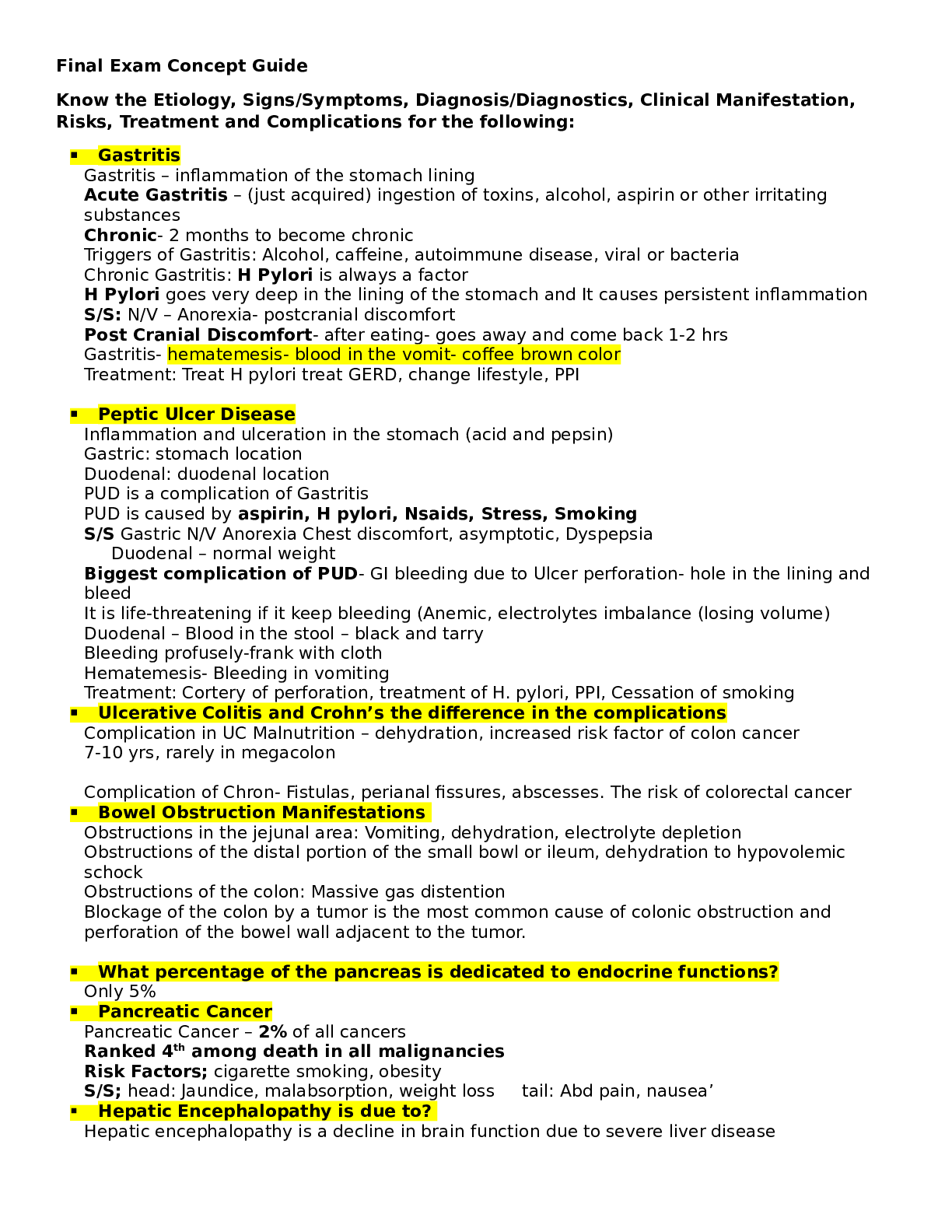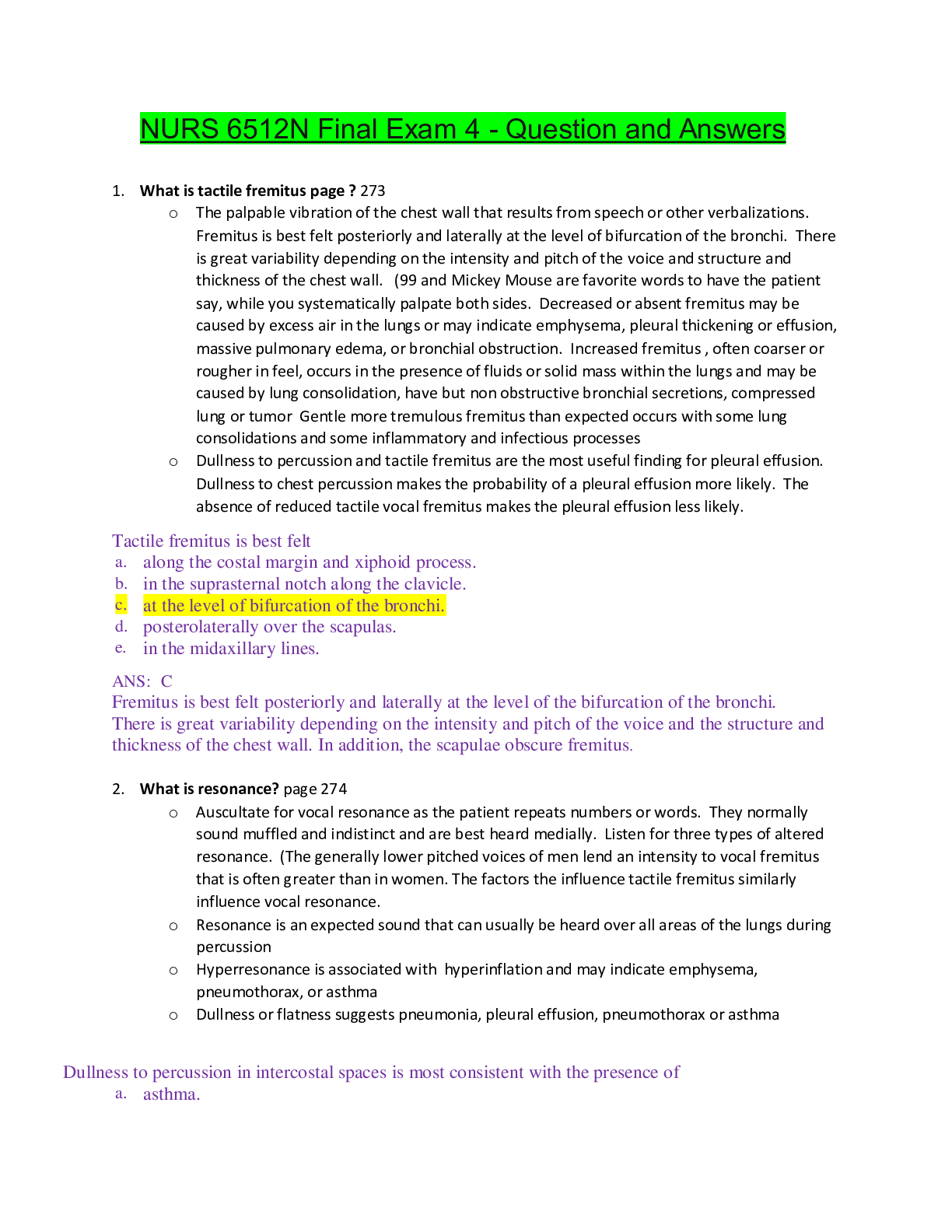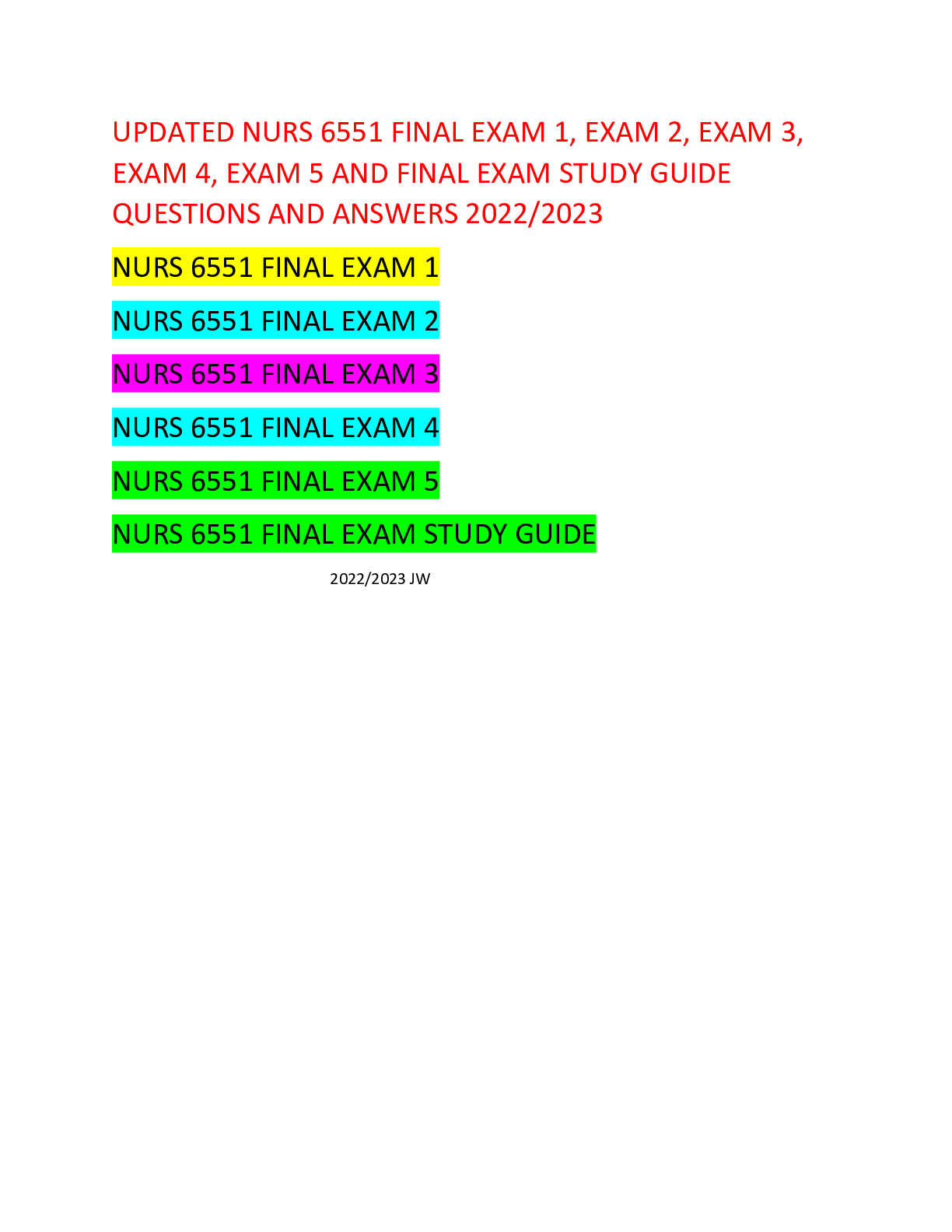*NURSING > Final Exam Review > Assessing Heart & Neck Vessels CHAPTER 25 6thEDITION GRADED A (All)
Assessing Heart & Neck Vessels CHAPTER 25 6thEDITION GRADED A
Document Content and Description Below
1. While auscultating the client's heart at the third intercostal space and on the left sternal border, the nurse notes a high-pitched, scratchy sound that increases with exhalation with the client le... aning forward. The nurse should document which of the following? A) Pericardial friction rub B) Midsystolic click C) Summation gallop D) Aortic ejection click 2. During chest auscultation, the nurse hears a quiet murmur immediately upon placing the stethoscope on the client's chest. The nurse interprets this as which grade? A) 1 B) 2 C) 3 D) 4 3. A group of students is reviewing the structures of the heart, noting that the thickest layer of the heart is made up of contractile muscle cells. The students are correct in identifying this layer as which of the following? A) Myocardium B) Epicardium C) Endocardium D) Pericardium 4. A nurse is reviewing the electrical conduction system of the heart in preparation for assessing a client with a conduction problem. The nurse should be aware that the electrical signal originates in which of the following locations? A) Bundle of His B) Purkinje fibers C) Sinoatrial node D) AV node 5. The nurse is analyzing the data from the assessment of a client's heart and neck vessels. The client's first heart sound corresponds with what event in the cardiac cycle? A) Isometric contraction B) Closure of the semilunar valves C) Beginning of diastole D) Closure of the atrioventricular valves 6. The nurse is assessing a client who is in uncompensated right-sided heart failure. What assessment finding should the nurse anticipate? A) Increased jugular venous pressure B) Bradycardia C) Decreased blood pressure D) Dysrhythmias 7. The nurse is assessing a client with a cardiac condition who complains of not sleeping well and of having to get up frequently at night to urinate. The nurse should recognize what implication of this statement? A) The client may have developed a cardiac conduction problem. B) The client may be experiencing symptoms of heart failure. C) The client's cardiac problem is being adequately compensated for. D) The client may be at increased risk for myocardial infarction. 8. The nurse is assessing a client's heart and neck vessels. Which technique would be most appropriate to use when examining the client's jugular venous pulse? A) Perform the exam with the client in a supine position. B) Have the client look straight ahead with chin slightly lifted. C) Have the client sit up at a 90-degree angle. D) Inspect the suprasternal notch or around the clavicles. 9. The nurse is preparing to assess a client's apical impulse. The nurse should palpate at which location? A) Second intercostal space, left sternal border B) Third intercostal space, left axillary line C) Fourth intercostal space, left sternal border D) Fifth intercostal space, left midclavicular line 10. A nurse is preparing a health education session for a local community group. When addressing the relationship between coronary artery disease (CAD) and culture, which information would the nurse include? A) Caucasians usually possess greater lifestyle risks for CAD than African Americans. B) Hypertension is more prevalent in African Americans than among Caucasians. C) Hypertension is seen more in white women than in African-American women. D) Hispanic Americans have a higher rate of CAD than white Americans. 11. The nurse is assessing a client with mitral insufficiency. Which characteristic of the first heart sound should the nurse expect to hear? A) Split B) Diminished C) Accentuated D) Varying 12. The nurse is assessing a client who has a complex cardiac history. The nurse has asked the client to lean forward while in a sitting position. This position will allow the nurse to do which of the following? A) Assess the client's heart sounds while preventing shortness of breath. B) Identify heart sounds that may be inaudible in other positions. C) Assess the impact of the client's heart disease on his mobility. D) Differentiate heart sounds from breath sounds. 13. A nurse is auscultating a client's heart sounds. What action should the nurse perform during this assessment? A) Start by auscultating the client's breath sounds. B) Auscultate prior to inspection and palpation. C) Use the bell rather than the diaphragm. D) Systematically listen to the entire precordium. 14. After teaching a group of students about the traditional areas of auscultation of heart sounds, the instructor determines that the teaching was successful when the students identify which of the following as Erb's point? A) Fifth intercostal space near the left midclavicular line B) Third to fifth intercostal space at the left sternal border C) Second intercostal space at the right sternal border D) Second or third intercostal space at the left sternal border 15. A nurse is reviewing a client's electrocardiogram (ECG). The nurse should identify which component as indicating ventricular repolarization? A) P wave B) QRS complex C) ST segment D) T wave 16. The nurse is preparing to assess a client's carotid arteries. Which of the following actions would be most appropriate? A) Palpate each artery individually to compare. B) Palpate the arteries before auscultating them. C) Use the diaphragm of the stethoscope. D) Ask the client to breathe in and out deeply. 17. A nurse auscultates a client's heart rate and rhythm and finds the rhythm to be irregular. Which of the following should the nurse do next? A) Inspect for a lift. B) Palpate for a thrill. C) Auscultate for pulse rate deficit. D) Listen for a ventricular gallop. 18. The nurse assesses a client's carotid pulse and finds it to be of normal amplitude. The nurse would document this as which of the following? A) 1+ B) 2+ C) 3+ D) 4+ 19. A nurse is having difficulty identifying a client's heart sounds, specifically S1 and S2. Which of the following would be most appropriate for the nurse to do? A) Use the bell of the stethoscope to help distinguish the sounds. B) Palpate the carotid pulse while auscultating the heart. C) Determine the pulse deficit. D) Palpate the apical impulse. 20. A nurse is preparing a class for a local community group on coronary heart disease. Which of the following recommendations should the nurse include as appropriate for reducing a person's risk? Select all that apply. A) Avoid eating carbohydrates. B) Eat foods low in sodium. C) Walk for at least 30 minutes/day. D) Limit alcohol intake to 3 drinks per day. E) Use relaxation techniques to manage stress. 21. A client has sought care with complaints of increasing swelling in her feet and ankles, and the nurse's assessment confirms the presence of bilateral edema. The nurse's subsequent assessments should focus on the signs and symptoms of what health problem? A) Myocardial infarction B) Heart failure C) Atherosclerosis D) Heart block 22. The nurse is using the COLDSPA mnemonic to assess a client's history of chest pain. What interview question addresses the ìAî in this assessment model? A) ìDo you have any other symptoms together with your chest pain, such as nausea, sweating?î B) ìIn your experience, what kinds of activities tend to cause your chest pain?î C) ìWould you describe your chest pain as being acute, or is it chronic?î D) ìWhat changes do you have to make in order to accommodate your chest pain?î 23. The nurse has begun the objective assessment of a client's heart and neck vessels and is assessing the client's jugular veins. What finding would the nurse consider to be normal in a healthy client? A) The jugular venous pulse is not visible when the client is sitting upright. B) The jugular veins are fully distended when the client is in a high Fowler's position. C) The jugular veins are distended when the client sits at 45 degrees. D) The jugular venous pulse is visible when the client lies supine. 24. The nurse is assessing the carotid arteries of a client with a history of heart disease. What action should the nurse perform during this assessment? A) Palpate the client's left and right carotid arteries simultaneously. B) Palpate the client's carotid arteries prior to auscultation. C) Instruct the client to inhale and exhale forcefully during auscultation. D) Palpate the client's carotid arteries gently if an occlusion is audible. 25. The nurse's auscultation of a 22-year-old client's apical heart rate reveals the presence of S3. When the client stands upright, the S3 is no longer audible. How should the nurse respond to this assessment finding? A) Make a referral to the client's primary care provider promptly. B) Perform a focused respiratory assessment. C) Recognize this as an early sign of left-sided heart failure. D) Recognize this as a normal assessment finding in this client. 26. The nurse is auscultating a client's heart sounds and hears what she believes to be a murmur. How should the nurse proceed with gathering further assessment data related to the suspected murmur? A) Auscultate with the bell and then without the stethoscope. B) Ask the client to ìbear downî (perform the Valsalva maneuver) while auscultating. C) Ask the client to inhale and exhale deeply while auscultating. D) Auscultate with the client in a variety of different positions. 27. The nurse is assessing an older adult client's heart and neck vessels. When attempting to palpate the client's apical impulse, what principle should guide the nurse's actions? A) The apical impulse will be irregular due to normal, age-related physiological changes. B) The apical impulse may be more difficult to palpate than in a younger client. C) The apical impulse will be found in a more medial location than in a younger client. D) The apical impulse will be easier to palpate if the client is in a standing position. 28. The nurse's auscultation of the client's heart sounds reveals the presence of a split S1. What conclusion should the nurse draw from this assessment finding? A) The client's ventricles are not contracting simultaneously. B) The client's aortic valve is incompetent. C) The client has left ventricular hypertrophy. D) The client's atria are not synchronized with the ventricles. 29. The nurse is integrating health promotion education into the assessment of a client's heart and neck vessels. What teaching point addresses the most significant risk factor for coronary artery disease? A) ìIf you can eliminate red meat from your diet, your risk of heart disease will drop significantly.î B) ìTry to ensure that you're screened for heart disease at least once every six months.î C) ìAnything that you can do to reduce stress in your life will benefit your heart health.î D) ìYour risk for heart disease will drop greatly if you're able to stop smoking.î 30. The nurse has assessed a client's neck vessels and is now preparing to auscultate the client's heart sounds. What action should the nurse perform during this phase of assessment? A) Rapidly auscultate all areas of the precordium and then repeat the assessments in greater detail. B) Stand on the client's left side, nearest the heart. C) Elevate the head of the client's bed to 30 degrees. D) Begin by auscultating the entire precordium with the bell of the stethoscope. [Show More]
Last updated: 1 year ago
Preview 1 out of 8 pages
Instant download

Buy this document to get the full access instantly
Instant Download Access after purchase
Add to cartInstant download
Reviews( 0 )
Document information
Connected school, study & course
About the document
Uploaded On
Mar 30, 2021
Number of pages
8
Written in
Additional information
This document has been written for:
Uploaded
Mar 30, 2021
Downloads
0
Views
60


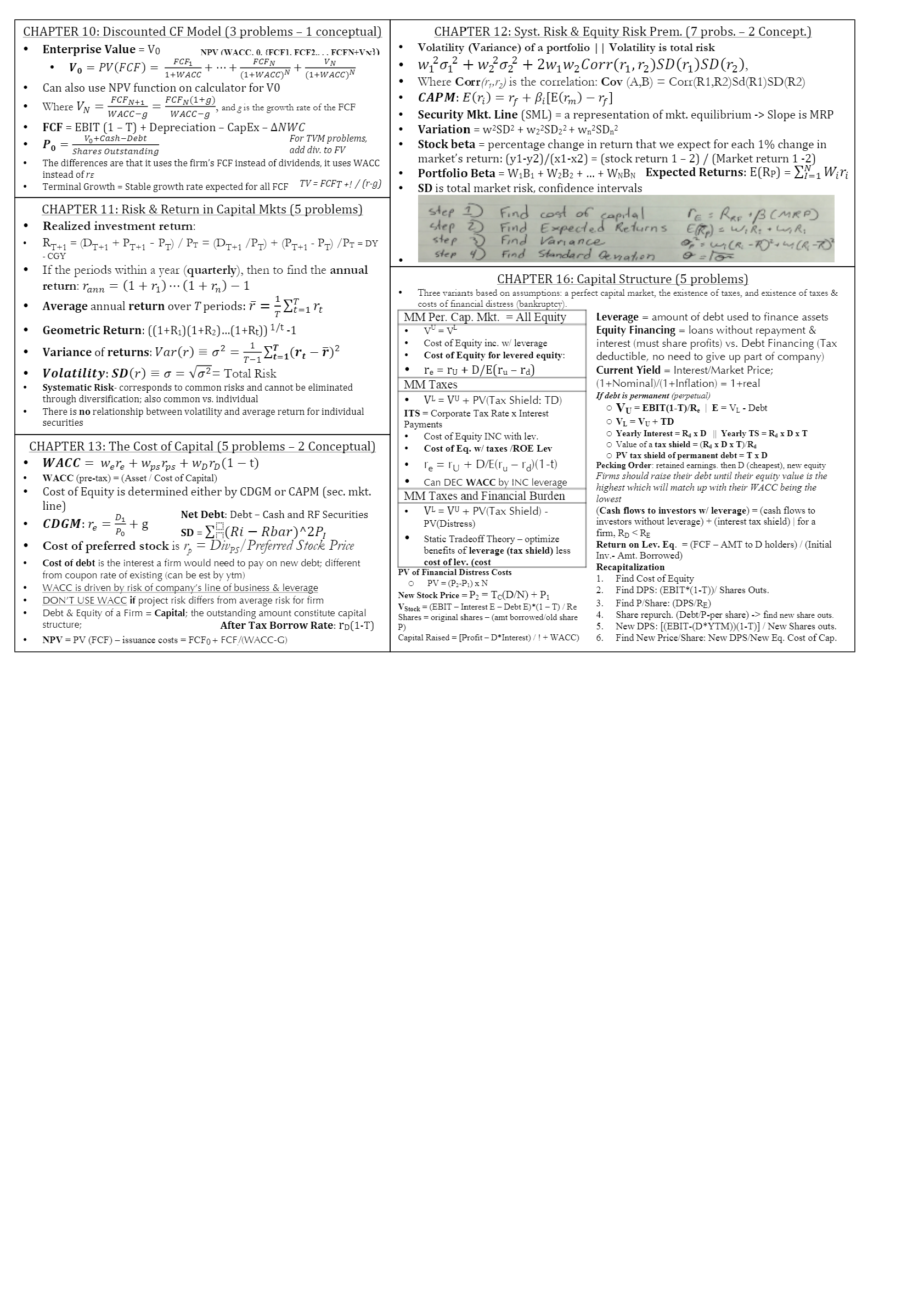
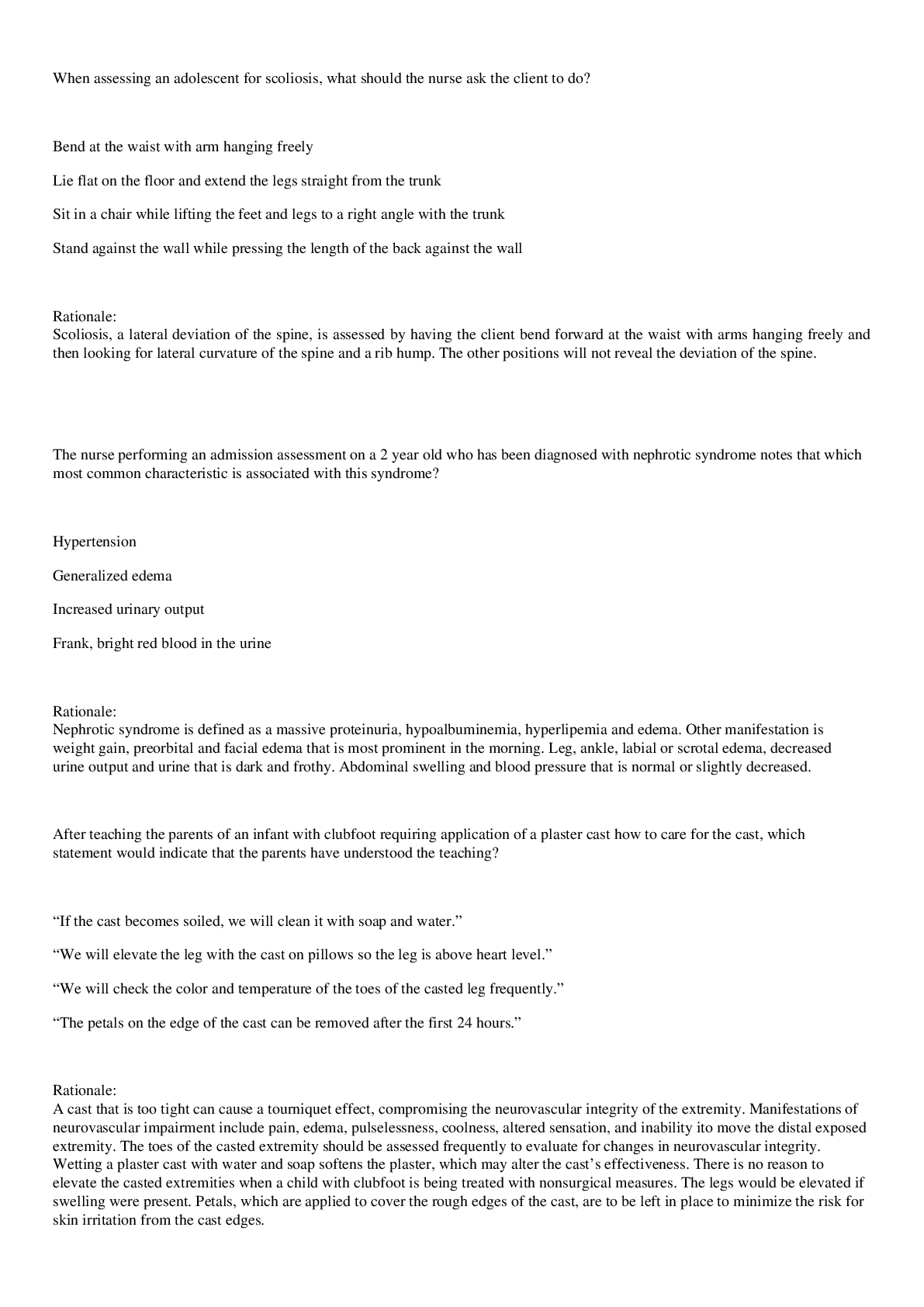
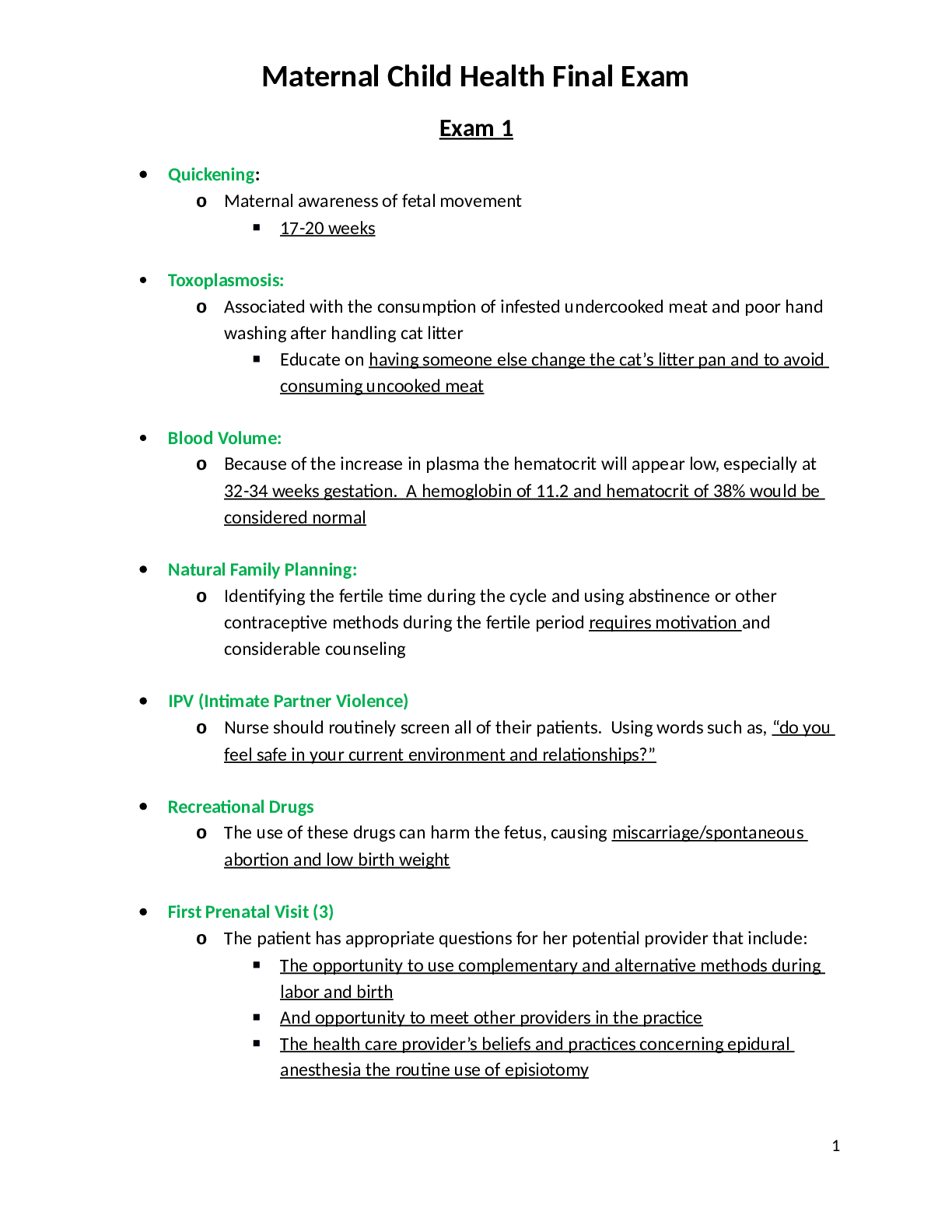
.png)
